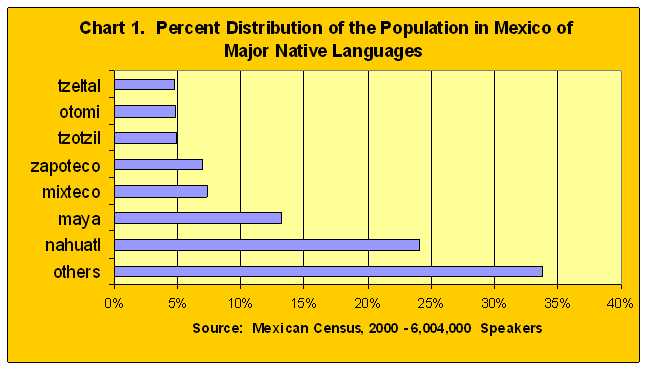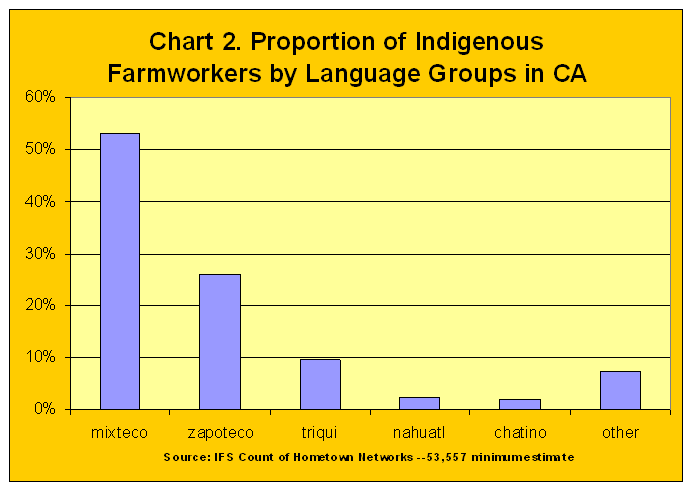Indigenous Languages
To approach the indigenous languages of Mexico is to begin to comprehend Mexico’s vast cultural and linguistic diversity, and come face-to-face with cultures that have endured for more than 500 years, despite systematic efforts to annihilate them. While many of the country’s indigenous languages and cultures have been lost over that period, linguists document over 350 indigenous, pre-Hispanic languages that are still spoken in Mexico today.
Some of this rich cultural and linguistic legacy is now present in California, as tens of thousands of Mexico’s indigenous peoples have come to the United States in search of a path out of poverty. We outline the facts and issues related to these new language groups in the sections below.
To hear samples of several of these languages, go to our video page where we present short interviews with speakers of six of these indigenous languages now found in California, with subtitles in English.
Main Mexican languages spoken in California agriculture
Potential threats to the native languages
Communication challenges within indigenous families
Languages found in California
Main Mexican indigenous languages spoken in California agriculture
Mexico has over six million native language speakers distributed among many distinct languages. Only seven of these languages (listed in the 1 below) make up two-thirds of all the indigenous language speakers in Mexico. Although all seven of these languages are present among by California farmworkers, only speakers of two of these—the Mixtecs and the Zapotecs, have a large presence in the state’s fields and orchards.
The Mixtecs and the Zapotecs each have about a half million speakers, accounting for those in both the United States and Mexico. There is a third group with a significant presence in California agriculture, the Triquis, but this is a smaller linguistic community with only about 40,000 speakers in Mexico and the United States combined. Together, members of these three language groups represent the great majority (about nine out of ten) of the Mexican indigenous farmworkers in California agriculture (see Chart 2, below). The other groups, such as the Nahuatl and Maya, although numerous in Mexico, have a small presence in California agriculture.

In all, in the Indigenous Farmworker Study, we found 23 different indigenous languages spoken in California agriculture, representing 13 different Mexican states.

Potential threats to the native languages
In recent decades, the overall population of speakers of these languages increased steadily in Mexico, from a total of about 3 million in 1970, to 6 million by 2000. However, for the first time in 2005, a small decline was registered in the number of indigenous language speakers in Mexico. It could be a turning point has been reached, and indications are that these native languages are facing severe threats to their survival in the decades to come. Young indigenous Mexicans appear to be losing interest in their ancestral tongues. Two other major factors are a falling birth rate, and the emigration of the indigenous to the United States and urban Mexico.
In rural California, the pressure on the young to shun the native language of their parents also appears quite common, though not universal. In our study we asked respondents whether they spoke exclusively in their native language to their relatives. Almost all speak the indigenous language to their parents, and a large majority speaks it to spouses and siblings. However, the practice of speaking in the native tongue to children declines as soon as the family gets established in the United States. After the third year in the United States only two in five continue to speak their native language to their children.Communication challenges within indigenous families
There is a major language barrier that exists within families among California’s indigenous population. Many parents speak only Spanish to their children. The parents are usually most fluent in the indigenous language and speak Spanish in a limited fashion. But the children, born here or who have come at a very early age, are often more comfortable speaking in English. Although both parents and children speak some Spanish, it is a second language for both sides, yet it becomes the de facto lingua franca of the household. This intra-family language barrier occurs on top of the already extreme cultural shock for these rural and traditional people who are trying to raise their children in an unfamiliar and, for them, an environment that’s out of their control.
This language barrier may explain some of the communication problems experienced by clinicians, social workers and educators who attempt to communicate with indigenous parents through their English-speaking children.
In all, in the Indigenous Farmworker Study, we found 23 different indigenous languages spoken in California agriculture, representing 13 different Mexican states. As noted earlier, Mixtec, Zapotec and Triqui speakers predominate and in the table below they appear in bold.
| List of Languages found in the Count of Hometown Networks (2007) | ||
| Language | State of Origin | |
| 1 | Aleto Cora | Nayarit, Durango |
| 2 | Amuzgo | Guerrero, Oaxaca |
| 3 | Chatino | Oaxaca |
| 4 | Chinanteco | Oaxaca, Veracruz |
| 5 | Chol | Chiapas, Tabasco, Campeche |
| 6 | Chontal | Oaxaca |
| 7 | Huichol | Nayarit, Durango, Jalisco |
| 8 | Maya | Yucatan, Quintana Roo, Campeche |
| 9 | Mazateco | Oaxaca, Puebla, Veracruz |
| 10 | Mixe | Oaxaca |
| 11 | Mixteco | Oaxaca, Guerrero, Puebla |
| 12 | Nahuatl | Puebla, Hidalgo, Veracruz,San Luis Potosí, Oaxaca, Colima, Durango, Guerrero, Jalisco, Michoacán, Morelos, Nayarit, Tabasco, Tlaxcala, Estado de México, Distrito Federal |
| 13 | Otomi | Hidalgo, Puebla, Veracruz, Queretaro, Michoacan, Tlaxcala, Estado de México, Guanajuato |
| 14 | Purépecha | Michoacán |
| 15 | Tacuate | Oaxaca |
| 16 | Taraumara | Chihuahua |
| 17 | Tlapaneco | Guerrero |
| 18 | Tojolabal | Chiapas |
| 19 | Triqui | Oaxaca |
| 20 | Tzetal | Chiapas, Tabasco |
| 21 | Tzotzil | Chiapas |
| 22 | Zapoteco | Oaxaca |
| 23 | Zoque | Chiapas, Oaxaca |
The Mexican Institute of Indigenous Languages (INALI) has a helpful map displaying the location and distribution of these and other indigenous languages.
